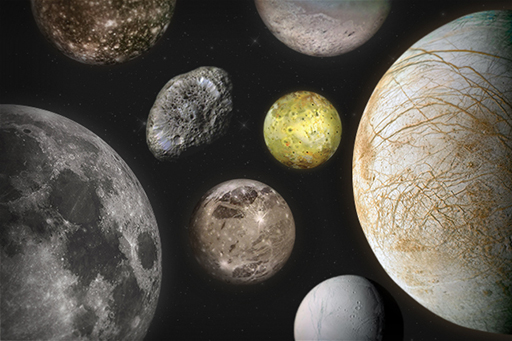1.1 Getting started with moons
In the first of the two previous videos, Keri Bean mentioned that the two moons of Mars are small and that these are probably captured asteroids, whose orbits are still changing significantly. Others then spoke about the moons that show the most obvious signs of present-day activity:
- Io, a moon of Jupiter, which is a rocky body with active volcanoes that colour its surface with sulfur
- Europa, another moon of Jupiter, with a rocky interior but an outer layer of ice and probably a global ocean sandwiched between the two
- Enceladus, a small icy moon of Saturn with a young, fractured surface and jets of ice crystals vented into space
- Titan, Saturn’s largest satellite, which has a dense atmosphere shrouding an icy surface that has rivers and lakes of liquid methane.
One important point that is not clearly mentioned is the low temperatures prevailing in the outer part of the Solar System. Out at Jupiter, whose distance from the Sun is five times the Earth’s, the average surface temperature on a moon is minus 170 degrees centigrade. The further from the Sun, the colder it gets: minus 200 degrees centigrade for Saturn’s moons, minus 210 degrees at Uranus, and minus 235 degrees at Neptune. This means that except where there is an internal heat source, the ice that forms the outer layers of all large moons (except the Moon and Io) is so cold, strong and rigid that it behaves exactly like rock does on the Earth or on the Moon.
Attention was also drawn to the Pluto–Charon system (which had not yet been visited when the video was made). Pluto is a dwarf planet made of ice. It is no longer counted as a true planet, but as one of the largest and nearest Kuiper Belt objects. Its major moon, Charon, has a diameter that is slightly more than half that of Pluto. Pluto and Charon are so close to each other that tidal forces have locked their rotations so that each keeps the same face permanently towards its partner. If you like, you can think of Pluto–Charon as a double object, rather than a main body plus a moon.
The video then turned to the Moon, meaning the moon that orbits the Earth. You will learn much more about the Moon later on, but the scientists gave you some hints about why this is an important body.
The video concluded by speculating about moons that could host life and about how resources from the Moon could open up the way for future exploration of the Solar System.
See also:
- Moons infographic [Tip: hold Ctrl and click a link to open it in a new tab. (Hide tip)] documenting the known moons of six planets (Venus and Mercury have no moons) and three dwarf planets in our Solar System. Note: since this infographic was made, a 4th dwarf planet (Makemake) has been shown to have a moon.
- New moons of Saturn 20 additional moons of Saturn discovered in 2019, giving it more known moons than Jupiter.
- New moons of Jupiter 12 additional moons of Jupiter discovered in 2018, putting it (temporarily) ahead of Saturn in the most-moons contest.

